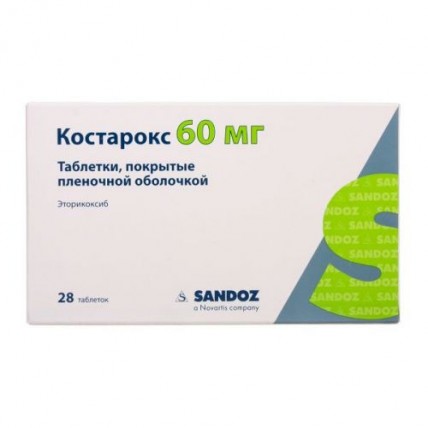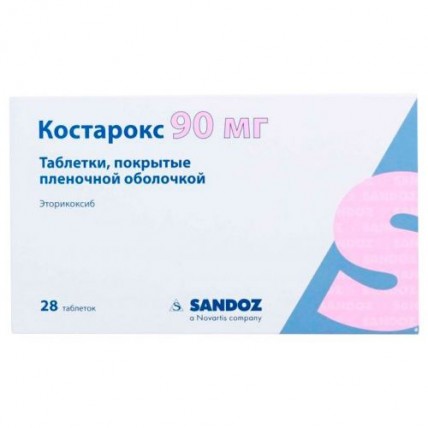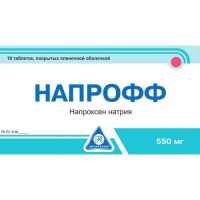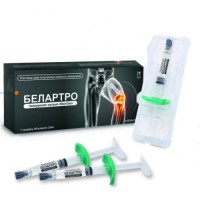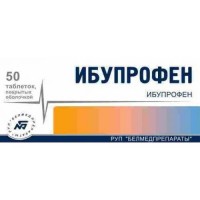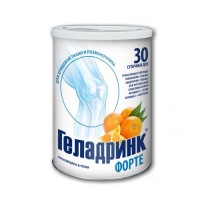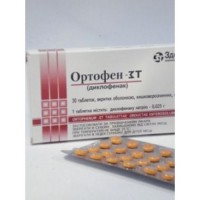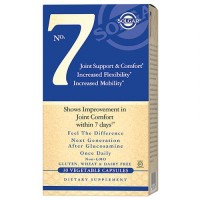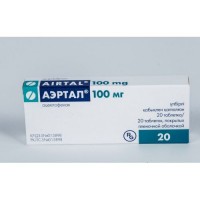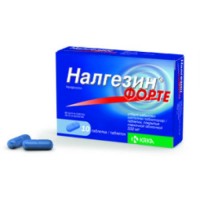Kostarox® (Etoricoxib)
- $32.00
Out Of Stock
Compound
One 30 mg film-coated tablet contains
active substance: etoricoxib 30 mg,
excipients: anhydrous calcium hydrogen phosphate, microcrystalline cellulose, povidone, magnesium stearate, croscarmellose sodium.
One 60 mg film-coated tablet contains
active substance: etoricoxib 60 mg,
excipients: anhydrous calcium hydrogen phosphate, microcrystalline cellulose, povidone, magnesium stearate, croscarmellose sodium.
One 90 mg film-coated tablet contains
active substance: etoricoxib 90 mg,
excipients: anhydrous calcium hydrogen phosphate, microcrystalline cellulose, povidone, magnesium stearate, croscarmellose sodium.
One 120 mg film-coated tablet contains
active substance: etoricoxib 120 mg,
excipients: anhydrous calcium hydrogen phosphate, microcrystalline cellulose, povidone, magnesium stearate, croscarmellose sodium.
Pharmacological properties
Pharmacokinetics
Suction. Etoricoxib is well absorbed when taken orally. Absolute bioavailability is about 100%. Following administration of 120 mg once daily until steady state, peak plasma concentrations (geometric mean Cmax = 3.6 μg/mL) were observed approximately 1 hour (Tmax) after ingestion in fasting adults. The geometric mean AUC0-24h was 37.8 μg h/mL. Within the range of clinical doses, the pharmacokinetics of etoricoxib is linear.
When taking etoricoxib at a dose of 120 mg with a meal (meal with a high fat content), there was no clinically significant effect on the extent of absorption. The absorption rate changed, which was characterized by a decrease in concentration (Cmax) by 36% and an increase in time (Tmax) by 2 hours, although these data are not considered clinically significant. In clinical studies, etoricoxib was administered with or without food.
Distribution. Etoricoxib is 92% bound to human plasma proteins over a concentration range of 0.05 µg/mL to 5 µg/mL. In humans, the volume of distribution at steady state (Vdss) is about 120 liters.
Etoricoxib crosses the placental barrier in rats and rabbits and also crosses the blood-brain barrier in rats.
Metabolism. Etoricoxib is extensively metabolized; less than 1% of the dose is excreted in the urine as the parent active substance. The main metabolic pathway is the formation of the 6-hydroxymethyletoricoxib derivative when catalyzed by cytochrome P450 (CYP) enzymes. CYP3A4 promotes the metabolism of etoricoxib in vivo. In vitro studies indicate that CYP2D6, CYP2C9, CYP1A2, and CYP2C19 may also catalyze the main metabolic pathway, but their quantitative characteristics have not been studied in vivo.
In humans, 5 metabolites have been identified. The main metabolite is 6'-carboxylic acid, a derivative of etoricoxib, formed by further oxidation of the 6'-hydroxymethyl derivative. These major metabolites, as inhibitors of cyclooxygenase-2 (COX-2), do not show measurable activity, or are only weakly active inhibitors. None of these metabolites inhibits cyclooxygenase-1 (COX-1).
Withdrawal. After a single intravenous injection of 25 mg radiolabeled etoricoxib, 70% of the radioactive etoricoxib is excreted in the urine and 20% in the feces, mainly as metabolites. Less than 2% is found as unchanged active substance.
Excretion of etoricoxib occurs mainly through metabolism, followed by excretion through the kidneys. Steady-state concentrations of etoricoxib are achieved within 7 days at 120 mg once daily, with an accumulation rate of about 2, corresponding to a half-life of about 22 hours. Plasma clearance after intravenous administration of etoricoxib at a dose of 25 mg is about 50 ml / min.
Separate groups of patients
Elderly age. Pharmacokinetics in elderly patients (over 65 years of age) is similar to that in younger patients.
Floor. The pharmacokinetics of etoricoxib is similar in women and men.
Impaired liver function. In patients with mild hepatic impairment (Child-Pugh score 5-6), when using etoricoxib at a dose of 60 mg once a day, the average AUC is approximately 16% higher than in healthy individuals with the same dose of etoricoxib. In patients with moderate hepatic impairment (Child-Pugh score 7-9), when using etoricoxib 60 mg once every other day, the mean AUC was similar to that in patients taking etoricoxib 60 mg once a day. day; etoricoxib 30 mg has not been studied in this group of patients. There are no clinical or pharmacokinetic data in patients with severe forms of hepatic impairment (≥10 points on the Child-Pugh scale).
Impaired kidney function. The pharmacokinetics of a single dose of etoricoxib 120 mg in patients with moderate to severe renal impairment, as well as in patients with end-stage kidney disease undergoing hemodialysis, did not differ significantly from that in healthy people. Hemodialysis has little effect on the excretion of etoricoxib (dialysis clearance is about 50 ml/min).
Children. The pharmacokinetics of etoricoxib have not been studied in children under 12 years of age.
In a pharmacokinetic study (n=16) conducted in adolescents aged 12-17 years, pharmacokinetics in adolescents weighing 40-60 kg when taking etoricoxib at a dose of 60 mg once a day and in adolescents weighing more than 60 kg when taking etoricoxib at a dose of 90 mg once a day was similar to the pharmacokinetics in adults taking etoricoxib at a dose of 90 mg once a day. The safety and efficacy of etoricoxib in children have not been established.
Pharmacodynamics
Mechanism of action. The drug Costarox® contains the active substance etoricoxib. Oral etoricoxib is a selective COX-2 inhibitor when used within the clinical dose range.
In clinical pharmacology studies, etoricoxib inhibited COX-2 in a dose-dependent manner without COX-1 inhibition at doses up to 150 mg per day. Etoricoxib does not inhibit the synthesis of gastric prostaglandins and does not affect platelet function.
Cyclooxygenase is responsible for the formation of prostaglandins. Two isoforms of COX-1 and COX-2 have been identified. COX-2 is an isoform of an enzyme that is induced by anti-inflammatory impulses and is considered to be the main factor responsible for the synthesis of prostanoid mediators of pain, inflammation, and fever. COX-2 is also involved in the processes of ovulation, implantation and closure of the arterial duct, regulation of kidney and central nervous system function (induction of fever, pain sensation, cognitive function); also, may be involved in the healing process of ulcers. COX-2 has been identified in tissue around human gastric ulcers, but significance for ulcer healing has not been established.
Indications for use
- osteoarthritis
- rheumatoid arthritis
- ankylosing spondylitis
- symptomatic treatment of pain and inflammation symptoms associated with acute gouty arthritis
- short-term treatment of moderate pain associated with dental surgery
The decision to prescribe a selective COX-2 inhibitor should be based on an assessment of all individual risks to the patient.
Dosage and administration
Costarox® is intended for oral administration, regardless of food intake. The onset of effect is faster if Costarox® is taken before meals, which should be taken into account if symptoms need to be relieved quickly.
Since the risk of cardiovascular complications with the use of etoricoxib may increase with increasing dose and duration of use, the minimum effective dose should be used for the shortest possible period of time. The need for symptomatic relief and response to treatment should be periodically reassessed, especially in patients with osteoarthritis.
Osteoarthritis
The recommended dose of Costarox® is 30 mg once daily. In some patients, in the absence of a sufficient effect, consideration should be given to increasing the dose to 60 mg once a day. If there is no effect, other possible treatments should be considered.
Rheumatoid arthritis
The recommended dose of Costarox® is 90 mg once daily.
Ankylosing spondylitis
The recommended dose of Costarox® is 90 mg once daily.
Acute pain conditions
The drug Kostaroks® should be used only in the period of acute pain syndrome.
Acute gouty arthritis
The recommended dose of Costarox® is 120 mg once daily. In clinical trials for acute gouty arthritis, etoricoxib was given for 8 days.
Postoperative pain in surgical dentistry
The recommended dose of Costarox® is 90 mg once daily for a maximum of 3 days. For some patients, it may be necessary to consider other methods of postoperative pain management.
Doses in excess of those recommended for each indication either have no additional efficacy or have not been studied.
Consequently:
- the dose for osteoarthritis should not exceed 60 mg per day;
- the dose for rheumatoid arthritis and ankylosing spondylitis should not exceed 90 mg per day;
- the dose for acute gout should not exceed 120 mg per day, for a maximum of 8 days of treatment;
- the dose for acute pain after dental surgery should not exceed 90 mg per day, and the treatment should be carried out for a maximum of 3 days.
Separate groups of patients
Elderly patients. Dose adjustment is not required for elderly patients. As with other drugs, caution should be exercised in elderly patients.
Impaired liver function. Regardless of the indication, in patients with mild hepatic dysfunction (Child-Pugh score 5-6), the dose of 60 mg once daily should not be exceeded. In patients with moderate hepatic dysfunction (Child-Pugh score 7-9), regardless of the indication, the dose of 30 mg once a day should not be exceeded.
Clinical experience is limited, particularly in patients with moderate hepatic impairment, therefore caution is advised. There is no clinical experience in patients with severe hepatic impairment (Child-Pugh score ≥10), so etoricoxib is contraindicated in these patients.
Impaired kidney function. Dose adjustment is not required for patients with creatinine clearance ≥30 ml/min. The use of etoricoxib in patients with creatinine clearance <30 ml/min is contraindicated.
Children. Etoricoxib is contraindicated in children under 18 years of age.
Side effects
Side effects are based on data from clinical studies and are classified according to the frequency of occurrence: very often (≥1/10), often (≥1/100, <1/10), infrequently (≥1/1000, <1/100), rarely ( ≥1/10000, <1/1000), very rare (<1/10000).
Often
- abdominal pain
Often
- asthenia/fatigue, flu-like illness
- dizziness, headache
- bronchospasm
- palpitations, arrhythmias, hypertension, edema/fluid retention
- constipation, flatulence, gastritis, heartburn/acid reflux, diarrhea, dyspepsia/
feeling of discomfort in the epigastric region, nausea, vomiting, esophagitis, ulcer in the oral cavity
- alveolar osteitis
- increased ALT levels, increased AST levels
- ecchymosis
Infrequently
˗taste perversion, insomnia, paresthesia/hypesthesia, drowsiness, anxiety, depression, mental deterioration, hallucinations
˗ blurred vision, conjunctivitis
˗ ringing in the ears, vertigo
˗ atrial fibrillation, tachycardia, congestive heart failure, nonspecific ECG changes, angina pectoris, myocardial infarction, hot flushes, stroke, transient ischemic cerebrovascular accident, hypertensive crisis, vasculitis
˗ chest pain, cough, dyspnea, epistaxis, upper respiratory infections
˗ bloating, altered intestinal motility, dry mouth, gastroduodenal ulcers, peptic ulcers, including gastrointestinal perforation and bleeding, irritable bowel syndrome, pancreatitis, gastroenteritis, decreased or increased appetite, weight gain
˗ proteinuria, increased serum creatinine, impaired renal function, including renal failure, urinary tract infections
˗ muscle spasms/cramps, musculoskeletal pain/stiffness
˗ hypersensitivity reactions, swelling of the face, pruritus, rash, erythema, urticaria
˗ anemia (mainly as a result of gastrointestinal bleeding), leukopenia, thrombocytopenia
˗ increased blood urea nitrogen, increased creatine phosphokinase, hyperkalemia, increased uric acid
Rarely
˗ confusion, restlessness
˗ hepatitis, liver failure, jaundice
˗ angioedema, anaphylactic / anaphylactoid reactions,
including shock, Stevens-Johnson syndrome, toxic epidermal necrolysis, persistent drug erythema
˗ Decreased sodium levels in the blood
Contraindications
˗ hypersensitivity to the active substance or any excipient that is part of the preparation
˗ acute peptic ulcer or acute gastrointestinal bleeding
˗ patients who have a history of developing bronchospasm, acute rhinitis, nasal polyps, angioedema, urticaria or other allergic reactions after the use of acetylsalicylic acid or NSAIDs, including COX-2 inhibitors (cyclooxygenase-2) inhibitors.
˗ pregnancy and lactation
˗ severe liver dysfunction (serum albumin <25 g/l or Child-Pugh ≥10)
˗ established renal creatinine clearance <30 ml/minute
˗ children under 18 years of age
˗ inflammatory bowel disease
˗ congestive heart failure (NYHA II-IV)
˗ persistent uncontrolled arterial hypertension above 140/90 mm Hg.
˗ established ischemic heart disease, peripheral arterial disease, and/or cerebrovascular disease
- persons with hereditary fructose intolerance, deficiency of the Lapp-lactase enzyme, malabsorption of glucose-galactose (due to the content of lactose monohydrate in the composition of the drug)
Drug Interactions
Pharmacodynamic Interactions
Oral anticoagulants. In patients stabilized on chronic warfarin, etoricoxib 120 mg daily was associated with an approximately 13% increase in prothrombin time International Normalized Ratio (INR). Therefore, in patients receiving oral anticoagulants, INR prothrombin time should be checked frequently, especially during the first days of taking etoricoxib or when changing its dose.
Diuretics, angiotensin converting enzyme (ACE) inhibitors and angiotensin II antagonists. NSAIDs may reduce the effect of diuretics and other antihypertensive drugs. In some patients with impaired renal function (eg, patients with dehydration or elderly patients with impaired renal function), concomitant use of an ACE inhibitor or angiotensin II antagonist and drugs that inhibit COX may lead to a subsequent deterioration in renal function, including possible acute renal failure. which is usually reversible. The possibility of such interactions should be borne in mind in patients who use etoricoxib concomitantly with ACE inhibitors or with angiotensin II antagonists. Therefore, this combination should be used with caution, especially in elderly patients.
Acetylsalicylic acid. The use of etoricoxib at a dose of 120 mg once a day did not affect the antiplatelet activity of acetylsalicylic acid (81 mg once a day). Etoricoxib can be administered concomitantly with acetylsalicylic acid, used in doses for the prevention of cardiovascular complications (low doses). However, the concomitant use of low doses of acetylsalicylic acid and etoricoxib may lead to an increased incidence of gastrointestinal ulcers or other complications compared with etoricoxib alone. The simultaneous use of etoricoxib with acetylsalicylic acid in doses exceeding those established for the prevention of cardiovascular complications, as well as with other NSAIDs, is not recommended.
Cyclosporine and tacrolimus. Although the interaction of etoricoxib with these drugs has not been studied, the simultaneous use of NSAIDs with cyclosporins and tacrolimus may increase the nephrotoxic effect of the latter. Renal function should be monitored when etoricoxib is co-administered with any of these drugs.
Pharmacokinetic interactions
The effect of etoricoxib on the pharmacokinetics of other drugs
Lithium. NSAIDs impair lithium excretion by the kidneys, thereby increasing plasma lithium levels. If necessary, conduct frequent monitoring of lithium levels in the blood and adjust the dose of lithium for the period of simultaneous use of these drugs, as well as when stopping the use of NSAIDs.
Methotrexate. Two studies examined the effects of etoricoxib at doses of 60 mg, 90 mg, and 120 mg once daily for seven days in patients who received once weekly methotrexate at a dose of 7.5 mg to 20 mg for rheumatoid arthritis. Etoricoxib at a dose of 60 mg and 90 mg did not affect plasma concentrations and renal clearance of methotrexate. In one study, etoricoxib 120 mg did not affect methotrexate, but in another study, plasma methotrexate concentrations increased by 28% and renal clearance of methotrexate decreased by 13%. With the simultaneous use of etoricoxib and methotrexate, appropriate monitoring should be carried out regarding the toxicity of methotrexate.
Oral contraceptives. Etoricoxib at a dose of 60 mg, when used simultaneously with oral contraceptives containing 35 μg of ethinylestradiol and 0.5-1 mg of norethindrone, for 21 days led to an increase in AUC0 24 of ethinylestradiol by 37%. Etoricoxib at a dose of 120 mg, when used with the above oral contraceptives simultaneously or with an interval of 12 hours, increased the AUC0 24 value of ethinyl estradiol by 50-60% at steady state. This increase in ethinylestradiol concentrations should be kept in mind when choosing an oral contraceptive to be used concomitantly with etoricoxib. An increase in exposure to ethinyl estradiol may increase the incidence of side effects associated with the use of oral contraceptives (for example, venous thromboembolism in women at risk).
Hormone replacement therapy. Taking 120 mg of etoricoxib with hormone replacement drugs, including conjugated estrogens (conjugated estrogens 0.625 mg), for 28 days increases the average AUC0 24 in the equilibrium state of unconjugated estrone (by 41%), equilin (by 76%) and 17-β-estradiol (by 22%). The effect of doses of etoricoxib recommended for long-term use (30 mg, 60 mg and 90 mg) has not been studied.
Etoricoxib at a dose of 120 mg reduced the exposure (AUC0 24) of the estrogenic components of conjugated estrogens by less than half compared with conjugated estrogens alone; the dose of the latter was increased from 0.625 mg to 1.25 mg. The clinical significance of these increases is unknown, and higher doses of conjugated estrogens have not been studied in combination with etoricoxib. Such increases in estrogen concentrations should be taken into account when choosing a hormonal drug for use in the postmenopausal period while using etoricoxib, since increased estrogen exposure may increase the risk of side effects with hormone replacement therapy.
prednisone / prednisone. In drug interaction studies, etoricoxib did not have a clinically significant effect on the pharmacokinetics of prednisone/prednisolone.
Digoxin. When using etoricoxib at a dose of 120 mg once a day for 10 days, there was no effect on the AUC0 24 at steady state on the excretion of digoxin by the kidneys. An increase in Cmax of digoxin was observed (approximately 33%). This increase is usually not significant for most patients. However, patients at high risk for the toxicity of digoxin should be monitored when co-administered with etoricoxib and digoxin.
Effect of etoricoxib on drugs metabolized by sulfotransferases.
Etoricoxib is an inhibitor of human sulfotransferase activity, in particular SULT1E1, and may also increase serum concentrations of ethinylestradiol. Since data on the effects of various sulfotransferases are currently scarce, and the clinical relevance of many drugs is still being studied, it is reasonable to administer etoricoxib with caution concomitantly with other drugs that are metabolized primarily by human sulfotransferases (eg, oral salbutamol and minoxidil).
The effect of etoricoxib on drugs metabolized by CYP isoenzymes.
Based on in vitro data, inhibition of cytochromes P450 (CYP) 1A2, 2C9, 2C19, 2D6, 2E1 and 3A4 is not expected with etoricoxib. In the study, daily use of etoricoxib at a dose of 120 mg had no effect on hepatic CYP3A4 activity, as determined by the erythromycin breath test.
Effect of other drugs on the pharmacokinetics of etoricoxib
The main route of metabolism of etoricoxib depends on the enzymes of the CYP system. CYP3A4 promotes the metabolism of etoricoxib in vivo. In vitro studies indicate that CYP2D6, CYP2C9, CYP1A2, and CYP2C19 may also catalyze the main metabolic pathway, but their quantitative characteristics have not been studied in vivo.
Ketoconazole. Ketoconazole is a potent inhibitor of CYP3A4. When used in doses of 400 mg once a day for 11 days, ketoconazole did not have a clinically significant effect on the pharmacokinetics of a single dose of etoricoxib 60 mg (43% increase in AUC).
Rifampicin. The simultaneous use of etoricoxib and rifampicin (a powerful inducer of CYP enzymes) led to a decrease in plasma concentrations of etoricoxib by 65%. This interaction may be accompanied by relapse of symptoms if etoricoxib is co-administered with rifampicin. While these data may indicate the need to increase the dose, it is not recommended to use etoricoxib in doses that exceed those indicated for each indication, since the combined use of rifampicin and etoricoxib at such doses has not been studied.
Antacids. Antacids do not have a clinically significant effect on the pharmacokinetics of etoricoxib.
Special instructions
Influence on the gastrointestinal tract. Gastrointestinal complications (perforations, ulcers or bleeding), sometimes fatal, have been reported in patients treated with etoricoxib.
It is recommended to use NSAIDs with caution in the treatment of patients with a high risk of developing complications from the gastrointestinal tract (patients who are simultaneously using any other NSAID or acetylsalicylic acid, patients with a history of gastrointestinal diseases such as ulcers or gastrointestinal bleeding).
There is an additional risk of side effects from the gastrointestinal tract (gastrointestinal ulcers or other complications from the gastrointestinal tract) with the simultaneous use of etoricoxib and acetylsalicylic acid (even at low doses). In long-term clinical studies, no significant difference was observed in terms of gastrointestinal safety when using a selective COX-2 inhibitor + acetylsalicylic acid and NSAIDs + acetylsalicylic acid.
Influence on the cardiovascular system. Clinical studies indicate that the use of selective COX-2 inhibitors may be associated with the risk of thrombotic complications (especially myocardial infarction and stroke) when compared with placebo and some NSAIDs. Since the risk of cardiovascular complications may increase with increasing dose and duration of use of etoricoxib, the drug should be used at the lowest effective dose for the shortest possible period of time.
The need for symptomatic pain relief and response to treatment should be reassessed periodically, especially in patients with osteoarthritis.
Patients with significant cardiovascular risk factors (such as hypertension, hyperlipidemia, diabetes mellitus, smoking) should only be treated with etoricoxib after careful consideration.
Selective COX-2 inhibitors are not substitutes for aspirin in the prevention of cardiovascular disease because they do not affect platelets. Therefore, the use of antiplatelet drugs should not be discontinued.
Effect on the kidneys. Renal prostaglandins may play a compensatory role in maintaining renal perfusion. Therefore, with a weakening of renal perfusion, the use of etoricoxib can cause a decrease in the formation of prostaglandins and, as a result, a decrease in renal blood flow and weakening of kidney function. The risk of such a reaction is highest in patients with pre-existing significant weakening of kidney function, uncompensated heart failure or cirrhosis. The possibility of monitoring renal function in such patients should be considered.
Fluid retention, edema and arterial hypertension. As with other drugs that inhibit the synthesis of prostaglandins, fluid retention, edema and hypertension have been observed in some patients taking etoricoxib. All NSAIDs, including etoricoxib, can lead to the onset or recurrence of congestive heart failure. With caution, the drug is prescribed to patients who have a history of heart failure, dysfunction of the left ventricle or arterial hypertension, as well as to patients with edema that has arisen for any other reason. If there are clinical signs of deterioration in these patients, appropriate measures should be taken, including discontinuation of etoricoxib.
The use of etoricoxib, especially at high doses, may be associated with more frequent and severe hypertension than some other NSAIDs and selective COX-2 inhibitors. Therefore, hypertension should be controlled before starting treatment with etoricoxib, and special attention should be paid to control of blood pressure during treatment with etoricoxib. With a significant increase in pressure, alternative treatment should be prescribed. Blood pressure (BP) should be monitored within 2 weeks after the start of treatment, and then periodically. If blood pressure rises significantly, alternative treatment should be considered.
Effect on the liver. Approximately 1% of patients treated with etoricoxib at doses of 30 mg, 60 mg and 90 mg per day in clinical studies lasting up to one year, there was an increase in the activity of alanine aminotransferase (ALT) and / or aspartate aminotransferase (AST) (approximately three times or more compared to the upper limit of normal).
All patients with symptoms and/or signs of hepatic dysfunction and those with abnormal liver function should be monitored. Etoricoxib should be discontinued if there are signs of impaired liver function or persistent pathological changes in liver function tests (three times the upper limit of normal).
General instructions. If during treatment the patient experiences deterioration in the function of any of the organ systems mentioned above, appropriate measures should be taken and consideration should be given to discontinuing etoricoxib. Appropriate medical supervision should be carried out when using etoricoxib in elderly patients and in patients with impaired renal, hepatic or cardiac function.
Caution should be exercised when initiating treatment with etoricoxib in dehydrated patients. Rehydration is recommended before starting etoricoxib.
The occurrence of serious skin reactions, in some cases with a fatal outcome, including exfoliative dermatitis, Stevens-Johnson syndrome and toxic epidermal necrolysis, has been very rarely reported with the use of NSAIDs and some selective COX-2 inhibitors during post-marketing surveillance. The highest risk of such reactions is at the beginning of therapy, and the onset of their manifestations, in most cases, during the first month of treatment. Serious hypersensitivity reactions (such as anaphylaxis and angioedema) have been reported in patients treated with etoricoxib. Some selective COX-2 inhibitors may increase the risk of skin reactions in patients with a history of allergic reaction to any drug. Etoricoxib should be discontinued at the first appearance of skin rash,
Etoricoxib may suppress symptoms of fever or other signs of infection.
Etoricoxib and warfarin or other oral anticoagulants are prescribed with caution at the same time.
The use of etoricoxib, as well as other drugs that inhibit COX and prostaglandin synthesis, is not recommended for women who are planning a pregnancy.
The composition of the drug Kostarox® includes lactose monohydrate. Patients with hereditary fructose intolerance, Lapp-lactase deficiency, glucose-galactose malabsorption should not use this drug.
Pregnancy and lactation
Pregnancy. There are no clinical data on the use of etoricoxib in pregnant women. The potential risk to pregnancy in humans is unknown. The use of etoricoxib, as well as other drugs that inhibit the synthesis of prostaglandins, is not recommended in late pregnancy, as this can lead to premature closure of the ductus arteriosus and cause a lack of uterine contraction. The use of etoricoxib is contraindicated during pregnancy. If pregnancy is diagnosed, treatment with etoricoxib should be discontinued.
Lactation. It is not known whether etoricoxib is excreted in breast milk. Etoricoxib is excreted into milk in vivo. Breastfeeding women should stop breastfeeding during treatment with etoricoxib.
Fertility. The use of etoricoxib, as well as other selective COX-2 inhibitors, is not recommended in women planning a pregnancy.
Features of the influence of the drug on the ability to drive a vehicle or potentially dangerous mechanisms
Patients who experience dizziness, vertigo, or drowsiness while taking etoricoxib should not be allowed to drive or use machines.
Overdose
Symptoms. The use of etoricoxib in single doses up to 500 mg or multiple doses up to 150 mg/day for 21 days did not cause significant toxic effects. Acute overdosage with etoricoxib has been reported, although no side effects have been reported in most cases. The most frequently observed adverse events were consistent with the safety profile of etoricoxib (eg, gastrointestinal adverse events, renovascular reactions).
Treatment. In case of overdose, it is advisable to apply the usual supportive measures, such as removal of unabsorbed etoricoxib from the gastrointestinal tract, clinical observation, and, if necessary, to carry out maintenance therapy.
Etoricoxib is not removed by hemodialysis; elimination of etoricoxib during peritoneal dialysis is unknown.
Storage conditions
Store at a temperature not exceeding 25°C.
Keep out of the reach of children!
Shelf life 3 years
Do not use after the expiration date.
